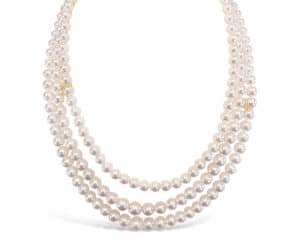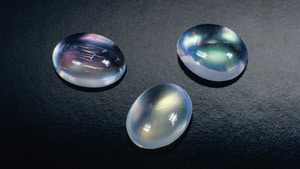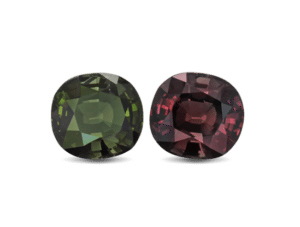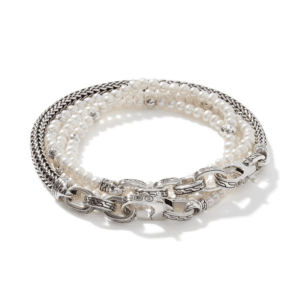June is one of only two months that boasts not just one, but three stunning birthstones: pearl, moonstone, and alexandrite. These gems are more than just pretty stones—they carry rich histories, deep symbolism, and unique beauty that cater to every taste and budget. Whether you’re looking for a meaningful gift or a piece of gemstone jewelry for June birthdays, this rare trio offers endless inspiration.
In this blog, we’ll uncover the origin, meaning, and allure of each of June’s birthstones—exploring their symbolism, color, and style to help you find the perfect stone for yourself or someone you love.

Pearl: June’s Timeless Classic
Pearls, long cherished for their luminous beauty, are steeped in romance, legend, and history. Unlike other gems born of fire and earth, pearls are born of water and living creatures, making them symbols of purity, mystery, and transformation. Ancient Greeks believed pearls were the hardened tears of joy shed by Aphrodite, the goddess of love, while in Chinese mythology, dragons held pearls in their mouths as symbols of wisdom and power. Cleopatra is said to have dissolved a pearl in vinegar and drank it to prove her love—and her wealth—to Marc Antony. Throughout centuries, pearls have adorned royalty and bridged cultures, whispered promises of love, and captured the essence of the sea in a single, delicate orb. Their timeless elegance continues to evoke the feeling that love, like a pearl, is both rare and enduring.
Cultured Pearls
Today, most pearls are cultured under controlled conditions. A small bead (often a mother-of-pearl nucleus) is implanted into a mollusk, which then coats the bead with layers of nacre over time. Not every mollusk produces gem-quality pearls—more than 10,000 may be sorted to create a single 16-inch strand.
Pearls come in a range of shapes, colors, and luster depending on the species and whether they are formed in saltwater or freshwater environments.
Saltwater Pearls
Saltwater pearls are typically rounder and more lustrous. Notable types include:
-
Akoya Pearls (Japan, China): Known for their perfect roundness and mirror-like shine, often in classic white or cream.
-
South Sea Pearls (Australia, Indonesia, Philippines): The largest cultured pearls, prized for their satin luster in shades of white, cream, or gold.
-
Tahitian Pearls (French Polynesia): Naturally dark, showcasing tones of gray, green, blue, and purple.
Freshwater Pearls
Cultured in rivers and lakes, freshwater pearls come in a wide array of shapes and pastel colors. Typically smaller and more affordable than saltwater varieties, they often resemble Akoya pearls in quality.
One standout is the Sterling Silver Multi-Wrap Bracelet by John Hardy, which features 3.5–4mm freshwater pearls for a delicate yet modern look.
From bridal accessories to everyday pieces, pearls are endlessly versatile and one of the most accessible and meaningful June birthstones.
Symbolism and Spiritual Meaning of Pearls: Astrology, Scripture, and the Shift to Alternatives
In both astrology and the Bible, pearls hold deep symbolic meaning that adds to their mystique and romantic allure. In astrology, pearls are linked to the Moon and the sign of Cancer, embodying intuition, emotional depth, and feminine energy. They are believed to calm the mind, balance emotions, and strengthen relationships, making them a favored talisman for love and inner peace. In Vedic or Hindu astrology, pearls are associated with the Moon’s nurturing power and are said to bring harmony to marital life and enhance spiritual insight.
In the Bible, pearls are revered as treasures of great worth. Perhaps most famously, Jesus speaks of the “pearl of great price” in a parable (Matthew 13:45–46), likening the Kingdom of Heaven to a pearl so precious that a merchant would sell all he owns to possess it. In Revelation, the gates of the New Jerusalem are described as being made of a single pearl each—emphasizing their divine and eternal beauty. In both celestial and sacred traditions, pearls symbolize purity, wisdom, and the soul’s journey toward love and truth.
One area where pearls have lacked versatility or have been too different from other gemstones is mother’s jewelry. Many families choose to make a ring, pendant, or cross at some point in their history that commemorates all of the family’s birthstones in one single piece. It’s essential, typically, for all of the gems to be the same size, quality, and cut. Pearl does not fit well into this style of jewelry; therefore, alternative options were introduced, as highlighted below.
Moonstone: The Mystical Gem of Intuition
With its soft glow and ethereal shimmer, moonstone has captivated jewelry lovers for centuries. Associated with intuition, love, and emotional balance, this gem is ideal for those drawn to calming energy and mystical allure.
In ancient Roman and Hindu traditions, moonstones were believed to be solidified moonbeams, sacred gifts from lunar deities. Lovers once exchanged moonstones during a full moon to deepen passion and ensure eternal devotion.
In folklore, moonstone was said to awaken tender feelings and grant the wearer visions of the future, especially in matters of the heart. It has been a talisman for travelers, dreamers, and romantics alike—symbolizing new beginnings, intuition, and feminine energy. Associated with the Moon and the zodiac signs Cancer and Pisces, moonstone is thought to soothe emotional turbulence, enhance empathy, and align the soul with the rhythm of the universe. To wear a moonstone is to carry a fragment of the night sky, a soft and luminous reminder that love, like the moon, waxes and wanes—but always returns.
What Is Adularescence?
Moonstone’s signature glow—known as adularescence—creates the illusion of light gliding across the surface. This dreamy effect comes from layers of feldspar minerals and resembles moonlight on water.

Moonstone belongs to the feldspar family , which makes up about 60% of the Earth’s crust. Sources include India, Brazil, Madagascar, the U.S., and especially Sri Lanka, known for rare high-quality moonstones with a vivid blue flash.
Durability and Jewelry Use
Moonstones are relatively soft, ranking 6–6.5 on the Mohs scale. They are best suited for pendants, earrings, and brooches rather than rings or bracelets that may face frequent wear.
Their soft shimmer and feminine quality make them a favorite in boho-chic and spiritual-inspired jewelry. If you’re looking for affordable birthstone jewelry, moonstone is an enchanting and accessible choice.
Alexandrite: The Chameleon of Gemstones
The rarest and most dramatic of June’s birthstones, alexandrite is prized for its incredible ability to change color—appearing green in daylight and red in incandescent light. This phenomenon earned it the nickname: “emerald by day, ruby by night.”
In Russian lore, alexandrite was believed to bring balance between the physical and spiritual, its shifting hues representing duality—love and logic, joy and sorrow, day and night. Some legends say it strengthens intuition and deepens emotional connection, making it a talisman for lovers destined to meet in unlikely ways. With its chameleon-like beauty and royal origins, alexandrite evokes a love story written in light itself—unpredictable, rare, and infinitely captivating.

History and Meaning
Discovered in 1830 in Russia’s Ural Mountains, alexandrite was named in honor of the future Czar Alexander II. Its red and green hues echoed the national colors of imperial Russia, making it a symbol of prestige and nobility.
Composition and Rarity
Made of the mineral chrysoberyl, alexandrite ranks 8.5 on the Mohs scale, making it durable enough for everyday wear. The stone’s color-shifting ability is due to its unique way of absorbing and reflecting different wavelengths of light.
In astrology, alexandrite is a powerful and mystical stone associated with transformation, balance, and the alignment of dual energies. It is often linked to the planet Mercury, which governs communication, intellect, and adaptability—mirroring the gem’s remarkable ability to shift color from green in daylight to red in incandescent light. This duality makes alexandrite a favored stone for those seeking harmony between the heart and mind, or navigating periods of change.
Alexandrite in Astrology
Alexandrite is also sometimes connected to the zodiac signs Gemini and Scorpio. For Geminis, it supports clarity of thought and emotional balance, while for Scorpios, it enhances intuition and deepens spiritual insight. In Hindu astrology, alexandrite is considered a substitute for emerald (the gem of Mercury) and is thought to bring good fortune, creativity, and heightened awareness. Believed to stimulate joy and inner strength, alexandrite is more than just a rare jewel—it is a celestial companion for those whose hearts are guided by both reason and romance.

Due to its scarcity, natural alexandrite is extremely expensive and difficult to source. Because of this, it was added as a June birthstone in the 1950s, providing a more distinctive (albeit rare) option. Later, moonstone was added to make birthstone jewelry for June more accessible to a wider audience.
Why Does June Have Three Birthstones?
Unlike other birthstone designations rooted in ancient traditions, June’s trio evolved from practicality. As demand for birthstone jewelry grew in the 20th century, pearl and alexandrite alone couldn’t meet the market’s needs.
-
Pearls, once rare, became more accessible through cultivation.
-
Alexandrite, while stunning, remained prohibitively rare and costly.
-
Moonstone was added to provide an affordable and enchanting third option.
Rather than a drawback, this diversity gives June-born individuals the unique gift of choice. Whether you’re drawn to the romantic glow of moonstone, the regal rarity of alexandrite, or the classic beauty of pearls, there’s a June gemstone to match every personality and occasion.
Final Thoughts: A Gem for Every Story
Having three birthstones may seem overwhelming, but it’s truly a rare privilege. With pearl, moonstone, and alexandrite, June offers more than gemstones—it offers reflection, personalization, and depth.
Whether it’s a freshwater pearl bracelet for a nature lover, a moonstone pendant for a free spirit, or a rare alexandrite ring to mark a milestone, each stone carries a unique resonance.
Birthstone jewelry is more than a gift; it’s a personal expression of identity, memory, and meaning.



















